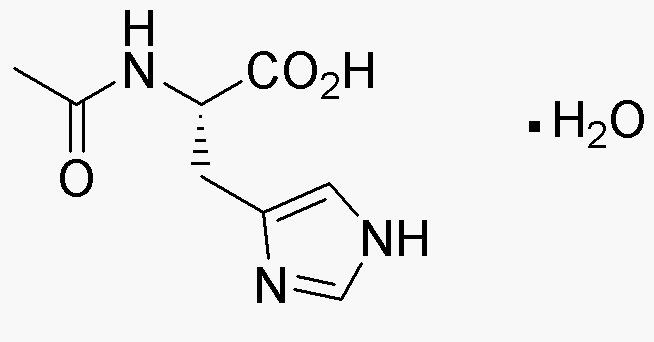Na-Acetyl-L-Histidine·H2O is widely utilized in research focused on:
- Biochemical Research: This compound serves as a valuable substrate in studies of enzyme activity, particularly in the context of histidine metabolism and its role in protein synthesis.
- Nutraceuticals: It is incorporated into dietary supplements aimed at enhancing cognitive function and reducing fatigue, due to its potential neuroprotective properties.
- Pharmaceutical Development: Researchers explore its effects in drug formulation, particularly in developing treatments for conditions related to oxidative stress and inflammation.
- Cell Culture Studies: Used as a supplement in cell culture media to promote cell growth and viability, especially in studies involving neuronal cells.
- Antioxidant Research: Investigated for its potential as an antioxidant, contributing to the development of products aimed at combating oxidative damage in various biological systems.
General Information
Properties
Safety and Regulations
Applications
Na-Acetyl-L-Histidine·H2O is widely utilized in research focused on:
- Biochemical Research: This compound serves as a valuable substrate in studies of enzyme activity, particularly in the context of histidine metabolism and its role in protein synthesis.
- Nutraceuticals: It is incorporated into dietary supplements aimed at enhancing cognitive function and reducing fatigue, due to its potential neuroprotective properties.
- Pharmaceutical Development: Researchers explore its effects in drug formulation, particularly in developing treatments for conditions related to oxidative stress and inflammation.
- Cell Culture Studies: Used as a supplement in cell culture media to promote cell growth and viability, especially in studies involving neuronal cells.
- Antioxidant Research: Investigated for its potential as an antioxidant, contributing to the development of products aimed at combating oxidative damage in various biological systems.
Documents
Safety Data Sheets (SDS)
The SDS provides comprehensive safety information on handling, storage, and disposal of the product.
Product Specification (PS)
The PS provides a comprehensive breakdown of the product’s properties, including chemical composition, physical state, purity, and storage requirements. It also details acceptable quality ranges and the product's intended applications.
Certificates of Analysis (COA)
Search for Certificates of Analysis (COA) by entering the products Lot Number. Lot and Batch Numbers can be found on a product’s label following the words ‘Lot’ or ‘Batch’.
*Catalog Number
*Lot Number
Certificates Of Origin (COO)
This COO confirms the country where the product was manufactured, and also details the materials and components used in it and whether it is derived from natural, synthetic, or other specific sources. This certificate may be required for customs, trade, and regulatory compliance.
*Catalog Number
*Lot Number
Safety Data Sheets (SDS)
The SDS provides comprehensive safety information on handling, storage, and disposal of the product.
DownloadProduct Specification (PS)
The PS provides a comprehensive breakdown of the product’s properties, including chemical composition, physical state, purity, and storage requirements. It also details acceptable quality ranges and the product's intended applications.
DownloadCertificates of Analysis (COA)
Search for Certificates of Analysis (COA) by entering the products Lot Number. Lot and Batch Numbers can be found on a product’s label following the words ‘Lot’ or ‘Batch’.
*Catalog Number
*Lot Number
Certificates Of Origin (COO)
This COO confirms the country where the product was manufactured, and also details the materials and components used in it and whether it is derived from natural, synthetic, or other specific sources. This certificate may be required for customs, trade, and regulatory compliance.


